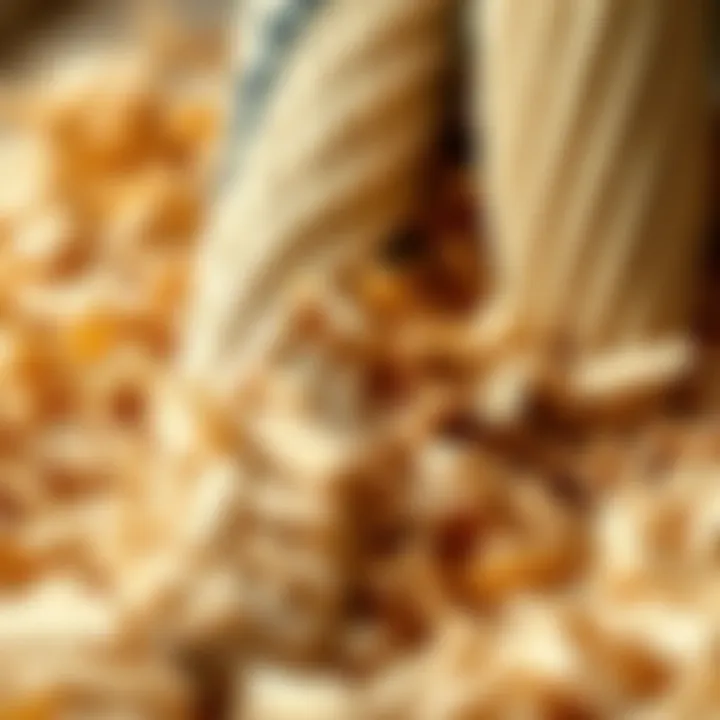Cedar Wood: Natural Solution for Moth Prevention


Intro
Cedar wood has carved a niche for itself in the world of natural moth prevention, boasting a rich history and robust characteristics that make it a go-to choice for safeguarding clothes and textiles. The war against moths is one that countless individuals and businesses face, particularly in the fashion sector where expensive fabrics and beloved garments are often under siege. If you're looking for solutions that align with eco-friendly principles while delivering results, this article unpacks the various dimensions of using cedar wood in moth prevention.
Throughout history, cultures have harnessed the unique properties of cedar. From the ancient Egyptians who used it in their burial rituals to modern fashion enthusiasts, cedar's aromatic qualities and chemical makeup have been found to deter moths effectively. In this discussion, we will delve into the chemical compounds present in cedar, explore historical usages, and highlight practical applications for both individuals and industry professionals.
Making a conscious choice to use cedar aligns perfectly with the current trend towards sustainability in fashion. As we examine the benefits and limitations of cedar, we’ll also reflect on the broader implications of such natural solutions in garment care and preservation. So, whether you’re a fashion aficionado or a retail professional, the following sections promise to provide rich insights into the protective prowess of cedar wood.
Understanding Moths and Infestations
Understanding moths and their infestations is critical in addressing the ongoing challenges they pose, especially to textiles. Moths, often overlooked, can cause monumental damage to garments and other fabric items, leading to considerable financial losses for both consumers and retailers. Recognizing how these pests behave and their lifecycle is a fundamental step towards implementing preventive measures. By gaining insight into the nature of these insects, one can approach prevention strategies more effectively, ensuring the longevity of treasured clothing and textiles.
Types of Moths Damaging Textiles
Moths that damage textiles generally fall into two main categories: the Clothes Moth and the Carpet Moth. Each type has its distinct characteristics and preferences, making their identification crucial for pest management.
- Clothes Moths: Primarily, the Webbing Clothes Moth and the Casemaking Clothes Moth are known to wreak havoc on wool, silk, and cashmere. The former prefers to feast on unprotected fabrics, while the latter creates small cases from fibers, making it easier for them to hide and protect themselves.
- Carpet Moths: These moths are notorious for targeting natural fibers in carpets and upholstery, often leading to significant losses in households and businesses. Adult carpet moths are often less visible due to their subdued colors, but their larvae are well-known for their destructive feeding habits.
These moths thrive in dark and undisturbed environments, such as closets and attics, which makes it imperative for fabric owners to take proactive steps in safeguarding their possessions.
Life Cycle of Moths
The life cycle of moths consists of four stages: egg, larva, pupa, and adult. Understanding this cycle is key to tackling infestations before they escalate:
- Eggs: Female moths lay anywhere from 40 to several hundred eggs on or near food sources. They are often too tiny to notice with the naked eye, which makes prevention tricky.
- Larvae: This is the most destructive stage as the larvae feed on fibers. Depending on environmental conditions, they can take several months to pupate. During this time, they can inflict significant damage, leading to holes in fabric or, in severe cases, rendering items completely unusable.
- Pupa: The pupa stage is a transformation period during which larvae develop into adults. This stage generally lasts a few weeks. While larval feeding stops during this phase, it is crucial to eliminate any lingering pupae before they mature.
- Adult: Once they emerge as adults, the cycle begins anew, as they rapidly seek mates to propagate. Adult moths are often seen fluttering around lights, signaling a potential infestation nearby.
Symptoms of Infestation
Identifying a moth infestation early saves a lot of time and resources. Here are some key indicators:
- Damage to Fabrics: Look for irregular holes in clothing or linens, which is often the first physical sign of moth larvae feeding.
- Presence of Larvae: Finding small white caterpillars or cocoons in storage areas is a clear indicator that you are dealing with an infestation.
- Adult Moths: Spotting adult moths, especially near clothing storage, is an immediate warning sign that action is needed.
- Frass: Tiny black specks or feces, often found near damaged items, can also be a telltale sign of larvae activity.
"An ounce of prevention, is worth a pound of cure." Addressing these signs promptly can save valuable time and effort, ensuring your textiles remain intact and preserved for the future.
The Science Behind Cedar Wood
Understanding the scientific foundation of cedar wood is crucial for appreciating its role in moth prevention. Cedar possesses unique properties that make it not only a sought-after material in various applications but also an effective natural deterrent against pests. These benefits stem from its chemical makeup and the inherent characteristics that repel damaging insects. As we dive into the specific elements of cedar's science, it's essential to note how these factors can contribute to sustainability in pest management.
Chemical Composition of Cedar
Cedar wood is rich in essential oils, which are primarily responsible for its distinctive aroma and myriad of beneficial properties. The most notable of these oils are cedrol, thujaplicin, and cadinene. These compounds are not just responsible for cedar's appealing scent; they inherently provide protective qualities for the wood, enabling it to resist decay and infestation.
- Cedrol - This is a primary component of cedar's essential oil that contributes to its insect-repelling abilities. It creates an unfavorable environment for moths and other pests, minimizing their likelihood of breeding.
- Thujaplicin - This compound offers antifungal properties, helping to protect textiles stored in cedar from mold and mildew that may arise in humid conditions. In commercial applications, thujaplicin can extend the lifecycle of wood products by preventing degradation.
- Cadinene - Another key oil, cadinene is known for its antibacterial and insecticidal properties, making cedar a natural barrier against pest infestations that threaten valuable fabrics.
The unique blend of these chemicals makes cedar wood a remarkable substance in pest control applications, particularly in environments where textiles are stored. The volatile oils volatilize in the air, creating a protective aura around the cedar, which often acts as a deterrent to hostile insects like moths.
Natural Repellent Properties
Cedar's natural repellent properties stem from the volatile oils mentioned above. Unlike synthetic repellents, cedar wood offers a non-toxic alternative, making it safe for use in homes, closets, and other storage spaces. It's like having a guardian that watches over your cherished items, tirelessly warding off those hungry moths.
- Long-lasting Protection: Cedar wood doesn't quickly lose its effectiveness; in fact, even when the oils begin to wane, the repellent qualities remain, offering continuous defense in smaller concentrations.
- Versatility in Use: Its applications range from building wardrobes and closet linings to the manufacturing of cedar sachets and chips, which can be placed in drawers or with stored fabrics.
- Biodegradable Characteristics: Utilizing cedar is not just about aesthetic appeal or efficiency; it's also rooted in environmental responsibility. As a natural product, cedar decays harmlessly and contributes to the ecosystem rather than burdening it with chemicals.
"Using cedar wood in pest control promotes a healthier environment, leveraging nature's own defense mechanisms rather than reverting to artificial solutions."
The science behind cedar wood, particularly regarding its composition and natural repellent properties, supports its inclusion as a preferred method for preventing moth infestations. Understanding these elements equips both consumers and industry professionals to make informed decisions about pest prevention strategies in their storage practices. By realizing the fascinating science behind cedar, stakeholders can better appreciate its significance in fostering both sustainable and effective moth management solutions.
Historical Uses of Cedar Wood
Cedar wood has enjoyed a long and storied history, woven intricately into the fabric of various cultures and civilizations. This section highlights its historical significance, especially in its applications for moth prevention, making it an essential topic in understanding how this remarkable material has stood the test of time.
Cedar in Ancient Civilizations


The ancient world revered cedar wood for more than just its durability; it was a symbol of strength and protection. The Egyptians, for example, used cedar extensively. They believed it to be a wood of the gods, often incorporating it into the construction of their temples and tombs. Its aromatic properties were not only pleasant but also beneficial in curbing pest infestations, making it a natural choice for storing the belongings of the deceased.
In the context of moth prevention, this practice can be traced back to the way ancient peoples viewed preservation. Cedar wood’s natural oils acted as a formidable barrier against pests, which was crucial in an era where textiles were more than simple fabric; they were seen as valuable investments. Notably, artifacts uncovered from this period often reveal the use of cedar in clothing storage, demonstrating its role in protecting these textiles from the ravages of time and moths alike.
Cedar in Traditional Textile Storage
Moving forward to more recent centuries, cedar wood found its way into traditional textile storage solutions across various cultures. Cedar chests, often elaborately carved and sometimes lined with silk or other delicate materials, became synonymous with heirloom preservation. People would often place their fine linens and garments inside these chest, confident in cedar's ability to keep moths at bay.
Historically, the use of cedar was not just practical but also steeped in culture; it represented a wise investment in the preservation of one’s possessions.
The process of using cedar as a moth repellent goes beyond its physical barrier; the essential oils emitted by cedar have a calming effect on fibers, preventing them from deteriorating. This understanding was pivotal for families, particularly those who relied on finely woven textiles for their livelihood. Household traditions included regularly replenishing cedar reserves within chests, echoing practices that still resonate today.
Practical Applications of Cedar for Pest Prevention
When it comes to preserving textiles, cedar wood offers practical solutions that are both effective and environmentally friendly. The unique properties of cedar have made it a go-to choice for safeguarding cherished garments and textiles. This section delves into specific applications of cedar that can significantly help in moth prevention, proving essential for anyone looking to maintain the quality of their wardrobe and household textiles.
Cedar Wood Closets and Storage Solutions
Cedar wardrobes and closets provide more than just storage; they create a natural barrier against moth infestations. The aromatic oils released by cedar wood not only create a pleasant scent but also work to repel pests like moths. Consider a cedar-lined closet or a cedar chest as prime options for keeping your textiles in peak condition.
- Air Circulation: Cedar wood's porous nature allows for air circulation, reducing moisture build-up which can attract pests.
- Longevity: Built to last, cedar storage solutions can handle wear and tear over time, thus providing a prolonged defense against infestations.
- Aesthetic Appeal: Beyond functionality, the rich color and grain of cedar make these solutions visually appealing, adding a touch of elegance to any space.
If you’re focusing on bespoke storage, integrating cedar panels within existing closets can easily elevate your moth prevention strategies while also enhancing the overall look.
Cedar Sachets and Chips
While large-scale storage solutions like closets are beneficial, cedar sachets and chips offer a versatile and affordable alternative. These compact forms can be strategically placed within drawers, bags, and even shoe boxes to provide ongoing protection.
- Ease of Use: Simply toss a sachet into a drawer or hang one in a closet. The aromatic properties begin to function right away.
- Rechargeability: By lightly sanding the chips or sachets, one can refresh their deterrent effect, ensuring ongoing protection for years.
- Natural and Non-Toxic: Unlike chemical repellents, cedar sachets are safe for both users and the environment, making them a smart choice for households with children or pets.
"Incorporating cedar sachets into your routine is like having a silent guardian, quietly working to keep moths at bay."
Incorporating Cedar into Wardrobe Management
The role of cedar in wardrobe management extends beyond mere pest prevention. Using cedar thoughtfully can foster a more resilient and organized wardrobe strategy.
- Seasonal Storage: When switching out wardrobes seasonally, utilizing cedar-lined boxes can help protect off-season garments from moths.
- Regular Maintenance: Making a habit of checking fabric items and refreshing cedar products can lead to a proactive approach to moth management.
- Education and Awareness: Understanding how moth behavior ties into textile storage can guide individuals in applying cedar effectively. For instance, knowing moths thrive in dark, warm spaces can emphasize the need for proper ventilation and light.
In summary, the applications of cedar wood for pest prevention are diverse and accessible. Whether you choose cedar closets, sachets, or a combination of both, making informed decisions can protect your treasures and ensure a moth-free environment.
Comparative Analysis of Cedar and Other Moth Deterrents
Moth prevention is a topic that requires careful consideration, especially for those who value the longevity of textiles and garments. While cedar wood has garnered attention for its natural properties as a moth deterrent, it’s essential to explore how it stacks up against other methods. This comparative analysis will shed light on chemical moth repellents and synthetic alternatives, providing insights on their respective advantages and drawbacks.
Chemical Moth Repellents
When discussing chemical moth repellents, it's vital to consider several factors, such as efficacy, safety, and environmental impact. Chemical repellents, like pyrethrins and permethrin, have been widely utilized for their effectiveness in killing moths and preventing infestations.
- Efficacy: Chemical repellents often act faster than natural options. They can provide immediate results by killing pests on contact, which can be appealing for those dealing with urgent infestations.
- Safety: However, many chemical repellents are synthetically produced, raising questions about their safety for humans and pets. Some can leave harmful residues on fabrics, making them a less desirable option for those who prioritize eco-friendliness.
- Environmental Concerns: The use of chemicals can lead to longer-term environmental harm as residues may seep into the soil, affecting local ecosystems. Organic alternatives, including cedar, become increasingly attractive as consumers seek safe solutions for their homes.
In summary, while chemical moth repellents can provide swift action, concerns about safety and ecological impact need to be highlighted.
Synthetic Alternatives
Synthetic alternatives offer a different approach to moth prevention. These products often include synthetic fragrances and essential oils designed to deter pests without the harsher chemicals found in traditional repellents. Their appeal lies in their diverse formulations and how seamlessly they can be integrated into daily life.
- User Experience: Many synthetic alternatives come in various forms, such as sprays, diffusers, or even as part of garment care products like detergents and fabric softeners. This versatility makes them an attractive choice for busy individuals seeking convenience.
- Variety of Options: Synthetic alternatives also capitalize on scent, often marketed with pleasing fragrances. This aspect can enhance user enjoyment, though it might not always be effective in repelling moths compared to cedar’s own natural aroma.
- Cost Considerations: Although these products can be effective, they can sometimes come at a premium price. Users might find themselves replenishing their supplies more frequently, raising overall costs.
In essence, synthetic alternatives present unique benefits, especially with their pleasent scents and convenience, yet effectiveness may vary.
In the end, the choice between cedar wood, chemical moth repellents, and synthetic alternatives boils down to personal preferences and specific needs.


Sustainability and Sourcing of Cedar Wood
In recent years, the conversation around environmental responsibility has turned a spotlight on various natural resources, cedar wood being one of them. As more people seek out eco-friendly solutions in daily life, understanding how cedar is sourced and its sustainability becomes essential. This section aims to shed light on sustainable practices within the cedar industry and the environmental impact of harvesting these valuable trees.
Sustainable Forestry Practices
Cedar trees are often revered not just for their natural insect-repelling properties, but also for their longevity. However, the health of cedar forests can be threatened by unsustainable logging practices. To combat this, sustainable forestry has emerged as a key element in preserving cedar resources. These practices ensure that cedar harvesting does not compromise the future availability of the trees.
Sustainable forestry includes methods such as selective logging, where only mature trees are harvested, allowing younger trees to continue growing. This practice not only maintains the ecology of the forest but also ensures that cedar wood remains a viable resource for years to come. Moreover, certifications such as that from the Forest Stewardship Council (FSC) signal to consumers that the cedar they are purchasing comes from responsibly managed forests.
"Using cedar responsibly helps preserve ecosystems while also reflecting a commitment to future generations."
This leads to a dual benefit; it protects natural habitats while enabling industries reliant on cedar, like fashion and textiles, to thrive without damaging the environment. Embracing such practices makes it clear that sustainability and quality can go hand in hand.
The Impact of Cedar Harvesting
The repercussions of cedar harvesting extend beyond mere numbers. When done unsustainably, logging can lead to habitat loss and a decline in biodiversity. It disrupts the delicate balance of the ecosystem, affecting not just the cedars but also various species that depend on those forests.
Consequently, the impact of cedar harvesting can include:
- Deforestation: Reduces the land available for wildlife, disrupting entire ecosystems.
- Soil Erosion: Trees play a crucial role in maintaining soil structure; without them, the land can degrade.
- Carbon Sequestration Loss: Trees absorb carbon dioxide, and cutting them down contributes to increased atmospheric CO2 levels.
However, there are significant strides being made to mitigate these effects. Companies that commit to sustainable sourcing often invest in reforestation projects, planting new trees to replace what has been cut down. This not only helps restore the forest but also ensures that future generations can benefit from cedar’s moth-repelling qualities.
Potential Limitations of Cedar as a Moth Repellent
Cedar wood is often celebrated for its natural ability to repel moths, making it a preferred choice among those seeking to protect their textiles. However, while cedar does offer several benefits in the realm of pest prevention, it is essential to explore the limitations that accompany its use. Understanding these constraints is paramount for fashion enthusiasts and retail professionals alike, as it enables a well-rounded approach to moth prevention strategies.
Efficacy Over Time
Over time, the effectiveness of cedar wood as a pest repellent can diminish. The chemical compounds that give cedar its moth-repelling properties, such as thujaplicins, may dissipate or degrade with exposure to air and light. Furthermore, the scent that initially deters moths can fade, especially in environments where humidity or temperature fluctuations are prevalent.
- Factors Impacting Efficacy:
- Frequency of Replacement: Regularly replacing cedar products, such as sachets or chips, is advisable. This can help maintain a consistent defense against moths, ensuring that your textile storage remains protected.
- Temperature Variation: In warmer environments, cedar might emit its fragrant oils more quickly, leading to faster evaporation of its repellent properties.
- Humidity Levels: Excess moisture can cause the wood to absorb water, diluting its natural compounds, which can lessen its pest-repelling effect.
It’s worth noting that while cedar can be beneficial, relying solely on it without periodic replacement or other pest control measures may leave textiles vulnerable to infestations long-term.
Environmental Considerations
When considering cedar wood as a repellent, one must also reflect on the environmental implications of its use. Cedar takes time to grow, which means that sourcing it sustainably is of utmost importance. Deforestation and poor forestry practices can lead to negative impacts on ecosystems, reducing biodiversity and compromising habitats.
- Sourcing and Sustainability: It's crucial to look for cedar products that come from responsibly managed forests. Organizations like the Forest Stewardship Council (FSC) provide certification that can guide consumers toward sustainable choices.
- Conserving Cedar Resources: Encouraging a circular economy, such as repurposing old cedar furniture or ensuring products are made from reclaimed wood, can mitigate environmental drawbacks. This practice not only reduces waste but also supports a sustainable approach to pest control.
In summary, while cedar wood serves as a natural defense against moths, its limitations in efficacy over time and the necessity for sustainable sourcing remain pivotal factors. A realistic understanding of these aspects can help in making informed decisions for long-term pest prevention and environmental stewardship.
“The allure of cedar lies not just in its protective qualities but in how we engage with it sustainably.”
For further insights on sustainable practices in forestry, you may explore resources such as FSC.org, or engage with discussions on platforms like Reddit surrounding eco-friendly pest control methods.
Expert Opinions on Cedar Wood Usability
Understanding the usability of cedar wood for moth prevention invites us to consider insights from industry professionals. These experts, whose daily work revolves around pest control and textile maintenance, provide essential perspectives that illuminate both the benefits and considerations of using cedar wood.
Interviews with Pest Control Professionals
In a world increasingly leaning toward natural solutions, pest control professionals have taken a keen interest in cedar wood's capabilities against moth infestations. Interviews conducted with seasoned experts reveal a robust consensus on cedar's effectiveness, not just as a deterrent, but as a long-term ally in preserving valuable textiles.
"Cedar wood doesn't just repel moths; it disrupts their life cycle. When used correctly, it can create an environment that is far less inviting for these pests," explains a seasoned pest control consultant. This sentiment is echoed across the board, with most professionals affirming that the aromatic oils present in cedar create a barrier that moths and their larvae tend to avoid.
The professionals also highlight the importance of proper application. Using cedar in strategic locations like closets, storage boxes, or even as sachets, further amplifies its effectiveness. Moths are notoriously attracted to dark, undisturbed areas—by placing cedar strategically, one can significantly reduce the chances of an infestation.


Key Insights from Interviews:
- Effectiveness: Cedar creates a repellent environment that interferes with moth behavior.
- Application: Effective use requires strategic placement to maximize properties.
- Sustainability: Natural deterrents like cedar align with modern eco-friendly practices.
Insights from Textile Experts
Textile experts bring to the table a wealth of knowledge on materials and preservation techniques. Their views on cedar wood reveal its nuanced significance in textile preservation, especially when it comes to vintage and sensitive fabrics.
One textile conservator noted, “Cedar not only repels moths but also helps in regulating humidity, which is essential for the longevity of textiles. It’s a win-win situation for anyone looking to protect their fabric investments.” This dual action of keeping moths at bay while promoting a stable environment for the textiles is pivotal for anyone devoted to caring for textiles.
Textile experts also stress the importance of understanding the unique needs of different fabrics. While cedar is effective, its use may need to be complemented with other textile care strategies, depending on the material's sensitivity. Not every fabric responds the same way, and attention to detail is crucial.
Considerations for Using Cedar in Textiles:
- Humidity Control: Cedar can modify ambient moisture, which can be beneficial for delicate fabrics.
- Fabric Compatibility: Different textiles may react variably to cedar; testing is recommended.
- Maintenance: Regularly renewing cedar products, such as chips or sachets, keeps their effectiveness intact.
By integrating insights from pest control professionals and textile conservators, it becomes clear that cedar wood serves a multifaceted role in moth prevention. The thoughtful application of cedar wood into storage and preservation routines not only safeguards valuable clothing but also embodies a commitment to sustainability, an increasingly vital consideration in contemporary fashion and retail domains.
Cedar in Modern Fashion Contexts
The modern fashion landscape is increasingly interconnected with sustainability and eco-conscious practices. Cedar wood emerges as a noteworthy player in this context, offering not only aesthetic appeal but also functional advantages in moth prevention. This section delves into the significant role that cedar wood plays within contemporary fashion, illuminating its multifaceted applications and benefits.
Integration in Sustainable Fashion
Sustainable fashion champions the use of environmentally friendly materials and processes. Cedar wood fits snugly into this narrative by providing a natural, chemical-free option to combat moth infestations, thus preserving textiles without the environmental toll associated with synthetic repellents.
- Natural Source: Cedar wood is harvested from trees that naturally thrive in various climates, often requiring fewer resources than synthetic alternatives.
- Biodegradable: As a natural product, cedar decomposes without leaving harmful residues, reducing ecological footprints.
- Ethical Production: Small-scale cedar producers often engage in sustainable forestry practices, gaining ground in an industry that demands transparency and responsibility.
Moreover, the infusion of cedar into the design aspect of garments can provide a unique touch. Its aromatic scent is often associated with renewal and freshness, adding an olfactory dimension to clothing pieces. This sensory appeal harmonizes well with the overall ethos of sustainability that many consumers today are searching for.
Cedar's Role in Preserving Vintage Clothing
The protection of vintage clothing is paramount for collectors and enthusiasts alike. Cedar wood serves as an invaluable ally in the preservation of these often irreplaceable textiles.
- Effective Repellent: Its natural oils are potent against moths, shielding delicate fabrics such as silk or wool from tarnishing over time.
- Humidity Control: Cedar possesses hygroscopic properties, meaning it absorbs moisture from the air. This trait helps to mitigate the damage that humidity can inflict on vintage textiles, thereby prolonging their lifespan.
- Aesthetic Presentation: Utilizing cedar storage solutions for vintage garments not only protects them but also enhances their display, presenting a rustic charm that compliments the historical nature of these pieces.
Cedar wood combines beauty with utility, weaving threads of sustainability into the fabric of fashion.
For further reading on sustainable fashion practices, you can explore resources like fashionrevolution.org and sustainablefashionforum.com, both of which provide valuable insights into integrating sustainability into modern garment production.
Epilogue and Future Directions
Navigating the murky waters of moth prevention in textile care can feel daunting, especially when faced with the myriad of options available. This conclusion ties together the threads of our investigation into cedar wood as a natural deterrent against moth infestations. Cedar’s unique chemical properties offer a sustainable solution, where nature plays a starring role in protecting invaluable fabrics. The benefits span not only the practical aspects of textile preservation but also touch upon the ethics of sourcing and utilizing a material that has stood the test of time.
Cedar wood’s valuable role in moth prevention validates its historical significance as well. This isn’t just a novelty; it’s a practice backed by science. Utilizing cedar in storage solutions or as small sachets helps prevent these pesky insects from damaging our clothing collections. It showcases a synergy between tradition and modern innovation, allowing today’s fashion enthusiasts and retail professionals to harness ancient wisdom in a contemporary context.
"Cedar wood’s ability to combat moths not only safeguards textiles but also champions sustainable practices, bridging fashion history with future innovations."
As we move forward, exploring the relationship between cedar wood and modern fashion contexts will be pivotal. The integration of such natural materials can lead to innovative solutions and broader ecological awareness. By marrying ethics and aesthetics, the industry can foster a more sustainable approach to clothing care and preservation.
Summary of Findings
The exploration of cedar wood’s role in moth prevention reveals a multifaceted advantage. From its chemical makeup, which naturally deters moths, to its historical uses, cedar has proven effective for safeguarding textiles. The article highlights cedar in various forms—closets, chips, and sachets—affording individuals and professionals flexible options for pest prevention.
Key insights include:
- The effectiveness of cedar wood against moths is rooted in its biochemical properties.
- Historical uses in various civilizations reiterate cedar's long-standing reputation.
- Practical applications facilitate both immediate prevention and ongoing maintenance of textile care.
Areas for Further Research
While the current investigation sheds light on many aspects of cedar wood’s effectiveness, there remain several areas that warrant deeper investigation. Understanding its long-term efficacy as a repellent over time could provide insights for optimal application.
Furthermore, delving into the environmental impact of cedar harvesting offers a comprehensive view of sustainability practices. A few crucial avenues for further exploration include:
- Longitudinal Studies: Researching the lasting effectiveness of cedar in varied climate conditions.
- Comparative Analyses: Evaluating cedar against synthetic repellents over extended periods.
- Population Impact Studies: Investigating the ecological ramifications of cedar sourcing.
In sum, by digging deeper into these areas, stakeholders can forge a path that not only improves pest control strategies but also upholds ethical standards in material use, thus fostering a more environmentally conscious approach to fashion and textile care.







